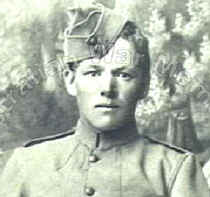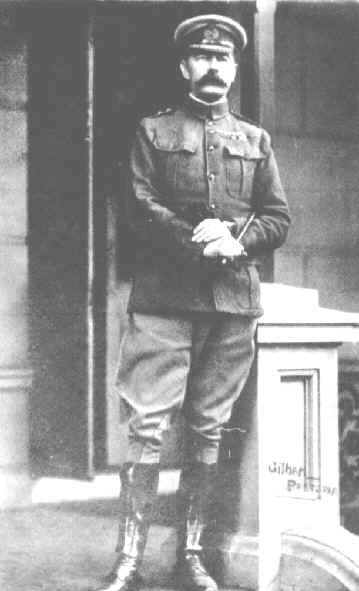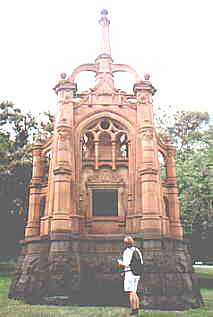|
On the evening of 12 June
1901, the Left Wing of the 5th Victorian Mounted Rifles, E F G and H
Squadrons, camped at Wilmansrust in South Africa's central Transvaal.
The encampment was
surprised when rushed in the dark by the Boers at about 7.30 pm. Their
first volley stampeded the horses in H Squadron lines through the camp.
The Boers were dressed in captured khaki uniforms and turned up hats. It
was impossible to tell friend from foe by the light of dying campfires.
 |
Private
George William Stratton, eldest son of Eliza Cook and Walter Thomas Stratton,
who was killed at Wilmansrust, South Africa, 1901-06-12, aged 19
years.
Stratton was a member of the 5th Victorian Mounted Rifles
contingent to the Boer War. (donor's uncle).
|
Victorian casualties were
heavy. Killed was Regimental Surgeon Herbert Palmer of Ballarat, and 18
NCOs and men. Five officers and 36 NCOs and men were wounded.
The Victorians were part of
a combined column commanded by British Major-General S. B. Beatson, a
stern disciplinarian. In the week after the Wilmansrust engagement, the
column remained in the vicinity.
For some reason General
Beatson was deeply, but unfairly, disturbed about the Wilmansrust action.
Until then he had seemed keenly impressed with the Victorians. Now, all
that had changed. He was reported to have angrily stated during a march
that week:
- "I tell you what I think. The
Australians are a damned fat, round shouldered, useless crowd of
wasters . . . In my opinion they are a lot of white-livered curs . . .
You can add dogs too"
-
- The facts were very different, with
Victorian mounted troops being generally acknowledged as formidable
opponents to the Boer 'Commandos', and terrifying to them in some
engagements. General Beatson , however, later found a group of
Victorians slaughtering pigs for food. He is said to have addressed
them as follows:
-
- "Yes, that's about what you
are good for. When the Dutchmen came the other night, you didn't fix
bayonets and charge them, but you go for something that can't hit
back".
-
- The column returned to Middelburg
depot later that week. There was by then a state of mutual contempt
between the General and the Victorians.
-
- On 7 July, when the Victorians were
ordered out on another operation. Trooper James Steele was overheard
by nearby British officers to say:
- 'It will be better for the men to
be shot than to go out with a man who called them white-livered
curs'.
- For this apparent refusal to do as
they were ordered, Steele and troopers Arthur Richards and Herbert
Parry were arrested, given a summary court-martial and sentenced
to death.
 |
- British supreme commander
Lord Kitchener intervened. He commuted the sentences (Steele
to do ten years gaol, the others to do one year each).
-
-
Controversy continued when a speech in the new Federal
Parliament lingered on how the aftermath of Wilmansrust was a
disgraceful way to treat men who had volunteered to go to the
Boer War.
-
- A court of enquiry earlier
had begun sittings three days after the disaster, at
Uitgedacht.
-
- The Wilmansrust camp had been under the overall
command of a British officer, Major CJN Morris, Royal Field
Artillery. He had personally chosen the position of the
picquets.
|
- In another extraordinary outburst
British General Sir Bindon Blood mentioned the 'chicken-hearted
behaviour of the officers and men generally of the Victorian Mounted
Rifles on this occasion. We must remember that they were all a lot
of recruits together, and that their behaviour was only what was to
be expected in the circumstances'.
-
- Since it was acknowledged that the
picquets were insufficient and wrongly placed (the responsibility of
Major Morris who had personally selected their positions), the
comments of Sir Bindon Blood and General Beatson before him were
grave slurs on the Victorians. Major William McKnight, the CO of the
5VMR Left Wing at Wilmansrust, called General Beatson to account for
his 'gross insults'. A belated apology by the General was curtly
refused by McKnight. The Court of Enquiry, meanwhile, had censured
British Artillery Major Morris.
-
- Melbourne newspapers heaped
criticism on General Beatson and his reported remarks. But it took a
petition to King Edward VII, and the personal representations of the
Australian Prime Minister Edmund Barton and prominent Australians
then living in London, to secure the release of the prisoners from
an English gaol. They were returned to South Africa and from there
to Victoria.
-
- Prime Minister Barton later tabled
a report on Wilmansrust by Victorian Major W. McKnight, who had been
present during the engagement. Because the convictions of troopers
Steele, Parry and Richards had by then been quashed, the complete
report was never made public. Most people seemed glad the whole
horrible episode quickly faded away.
-
- A strong defence of the 5th Mounted
Rifles and its humiliating defeat at Wilmansrust was provided by Max
Chamberlain in 1985, in his article The Wilmansrust Affair
(Australian War Memorial Journal No. 6; April 1985)
-
| webmaster's
note; many people, myself included, believe that this incident
had more to do with the later decision by the Australian
government that Australians must stay under Australian legal
control than the better known "Breaker Morant"
incident. |
-
- [The above was put together using the following
sources: Murray, Lt-Col P. L.: Official Records of the Australian
Military Contingents in the War in South Africa: Govt. Printer: n. d.,
1911? -- and the balanced viewpoint in Holloway, David: Hooves,
Wheels & Tracks: A history of the 4th/19th Prince of Wales Light
Horse Regiment and its predecessors: Regt. Trustees: 1990 and 'The
Wilmansrust Affair': Max Chamberlain: AWM Journal: No. 6: April
1985].
-
- about Wilmansrust
defeat and subsequent controversy
- National Archives of
Australia
-
Report by Major
McKnight on the Wilmansrust affair, 1901: B168, 1901/3859.
-
Papers re members of
the 5th Victorian Contingent being sentenced (courts martial) for
insubordination in South Africa, 1901-1902: B168, 1902/919.
-
Copy of minute from
Governor-General to Prime Minister--re telegram of condolence from
Duke and Duchess of Cornwall for heavy losses sustained by Victorian
Mounted Rifles near Wilmansrust, 1901: B3756, 1901/3426.
- This information compiled by Craig
Wilcox in forthcoming NAA Boer War guide.
|




